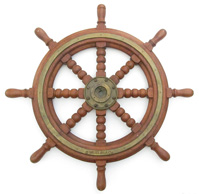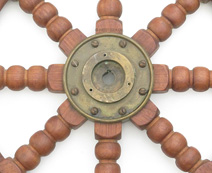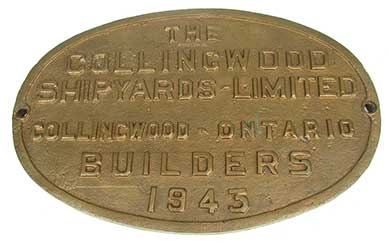SHIP RELICS
Catalog Page 8
When no price is shown, use
Click on photos for larger images.
Click
![]() for ordering details.
for ordering details.
|
8.13 EARLY SHIP’s REVOLUTION COUNTER. Turn-of-the -century American, ship’s shaft revolution counter made by the “Jas P. Marsh Corporation, Chicago” for the “General Machinery Corporation” as marked on the brass dial. This substantial, early solid bronze ship’s instrument is 9 ½ inches wide in diameter and 13 inches wide overall and weighs a hefty 14 pounds. It is a mechanical counter actuated by the lever on the left which rotates the 8 internal rotors that register up to 99+ million revolutions of an old fashioned reciprocating steam engine. The rotors themselves are brass with enameled numbers 0 – 9. The case is heavy solid bronze in a bright finish. It hinges open on the left to expose the complicated mechanism within. The rear flange is provided with three holes for mounting to the bulkhead. The handsome flared bezel measures 9 ½ inches in diameter and the case is 3 ¼ inches deep. The rear flange is 10 inches in diameter and measures 13 ¼ inches wide inclusive of the actuating lever. Excellent original condition. Fully functional. 695 |
|
PERSPECTIVE
|
MECHANISM
|
BACK
|
|
8.12 SMALL SHIP’s HELM. Very scarce, the first of its type we have seen, mid 1800’s ship’s wheel complete with steering gear box. This rare, surviving example consists of a classic pinned and dowelled 6 spoke wheel with wooden hub attached to its spindle by brass screws. The turned spokes are of oak and the body of the wheel is mahogany. The wheel revolves on a hand-forged inverted “V” brace in brass finish, held by a large brass acorn nut on the hub. The hub is attached to a stout brass rod running through the gear box, supported in back by a brass bearing and cotter pin. The internal wooden spindle, with the rod running through it, would have taken several turns of line which connected to the rudderhead by a series of pulleys. The arched top of the mahogany steering box is reinforced with brass straps and the entire piece is in its original old finish with nicely variegated surfaces indicative of its age and sea service. The entire presentation measures 23 ¼ inches tall overall. The wheel is 22 inches from spoke tip to tip and 16 inches in diameter on the rim. The steering box measures 18 inches wide and 14 ¼ inches deep from the front acorn nut to the rear support. Excellent original condition with good signs of use and no abuse. The wheel is nicely balanced and turns freely. A truly rare offering. 1595 |
|
PERSPECTIVE
|
BACK
|
SIDE
|
BOTTOM
|
DETAIL
|
|
SPINDLE
|
ORIGINAL FINISH
|
|
8.11 “OLD IRONSIDES” BOOK ENDS.
Scarce, matched pair of solid brass and
copper bookends made from the original material used to
construct the USS CONSTITUTION, affectionately
referred to as “Old Ironsides” These
detailed bookends are cast in the form of old fashioned
ship's helms depicting a port bow view of the venerable ship
under sail within a medallion reading "OLD IRONSIDES
Launched 1797 / 1804 Tripoli / 1812 Gurriere, Java / 1815
Cyane, Levant. FRIGATE CONSTITUTION." This
is encircled by a rope border studded with stars. On
the front of the base, cast in relief, is the declaration,
"THIS MATERIAL WAS TAKEN FROM U.S. FRIGATE CONSTITUTION
1927. Each bookend is weighted with a lead
insert on the bottom and measures 6 ½ inches high by 6
inches wide and 1 ¼ inches deep. Outstanding
original condition with wonderful age patina. The
Revere foundry in Canton Massachusetts produced all of the
copper nails, spikes, bolts, pins and sheathing for the
USS CONSTITUTION and many other early American
frigates. Accordingly the metal used to make these
bookends most certainly was produced by Paul Revere. 345
|
|
BACKS
|
BOTTOMS
|
INSCRIPTION
|
MEDALLION
|
|
DETAIL
|
BACK
|
LABEL
|
|
CLASS
|
SHIP
|
|
|
|
|
|
|
|
|
 |
|
8.02 WEST COAST HELM BELL.
Particularly nice 19th century sailing ship helm
bell identified by maker. This heavy, solid bronze
bell is stamped on the top of the yoke on both sides “W.T.
CARRATT & CO., SAN FRANCISCO.” It is of
classic 19th century form with a contoured yoke terminating
in flat brass feet. The bell is secured at the top by
a lovely acorn nut finial. The original iron clapper
is secured to the inside of the bell in an unusual way –
on a brass rod running across the inside top of the
bell. Attached to the clapper is the original cotton
bell rope done in a seamanlike fashion with fancy knotwork
terminating in a monkey’s fist. As configured
the bell stands 10 inches high and 12 inches wide. The
bell itself measures 7 ¼ inches in diameter at the
mouth. Excellent original condition with a lovely deep
statuary bronze age patina. There are numerous paint
spatters indicative of a long life at sea. A real gem
of a shipboard bell from the days of sail.
995 Bunting’s "Portrait of a Port, Boston 1852-1914" depicts a nearly identical helm bell on page 346 with the caption, “June 6, 1887, The ship Panay of Salem tows down the harbor.” |
|
INTERIOR
|
MAKER
|
PLATE
|
|
8.06 VOICE TUBE. Rare, early 1900’s
all brass speaking tube, probably from a World War II era or
earlier U.S. Navy ship. This heavy right angle tube features
a cast bronze elbow connecting two sections of 3 inches
grass tubing. The end terminates in an angled cast brass
opening fitted with a hinged cover. The ribbed cover
contains a rubber O-ring which seats positively on the
opening by means of a revolving locking lever. The speaking
tube measures approximately 3 inches in diameter and is 17
inches long to the elbow and another 14 inches long to the
open end. This substantial unit weighs 10 pounds! A very
scarce ship’s relic. The idea of the voice tube was simplistic in its design yet ingenious and very practical in its function. Believers in the KISS theory (Keep It Simple Stupid), early ship builders incorporated very basic systems into their production when possible. One of those was the voice tube which allowed communication within the ship from various key points such as the pilot house, engineroom, and navigation bridge. Another innovation along the same lines was the engine order telegraph of “E.O.T.” which used a series of cables to connect the pilot house with the engineroom to transmit speed changes. |
|
REVERSE
|
OPEN
|
|
8.05 PIRATE SHIP BELL. Genuine, 19th century ship’s bell marked “RED PIRATE.” This authentic old bell is cast of solid brass and is hand-engraved with the vessel's name along with a decorative flourish resembling a fleur-de-lis on a compass. The bell is complete with brass clapper and produces a loud tone when rung. The inside of the bell exhibits heavy green verdigris and evidence of marine encrustation, indicating it was submerged for a long period. Whether it was as a result of shipwreck is inconclusive, as we have found no reference to any such wreck. Nevertheless, this is an authentic ship’s bell with an intriguing name. Additional research may well reveal a storied past. 8 inches in diameter by 7 inches high. The real deal. 495 |
|
INTERIOR
|
DETAIL
|
|
REVERSE
|
KING SPOKE
|
HUB
|
|
8.03 IDENTIFIED FISHING BOAT WHEEL. Outstanding solid bronze helm identified with the vessel’s name “P-I-S-C-E-S” as marked under each of its six spokes. This authentic high seas relic has a heavy cast bronze frame with hardwood handle grips. The center has a 1 inch diameter arbor hole with a keyway aligned with the “King spoke” denoting rudder amidships. On the arm of that spoke is the first letter “P” of PISCES. This fine old ship’s wheel measures 16 inches in diameter on the rim and 23 ½ inches across from spoke tip to tip. Excellent original condition noting minor age checks in the wood with a nice patina to all surfaces. 479 Pisces is the twelfth astrological sign of the Zodiac, considered a “water sign.” According to Greek mythology Pisces represents the two fish into which the goddess of love, Aphrodite, and her son Eros, transformed in order to escape the monster Typhon on the Euphrates River. The fish were then placed in the heavens in honor of their saving Aphrodite and Eros from Typhon. |
|
BACK
|
DETAIL
|
SUPER DETAIL
|
 |








































































